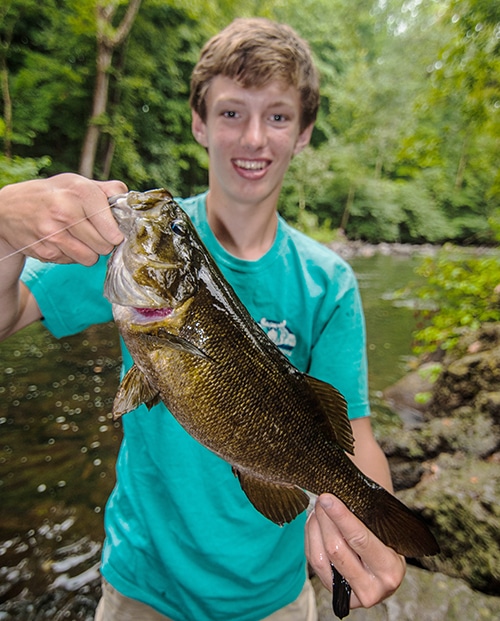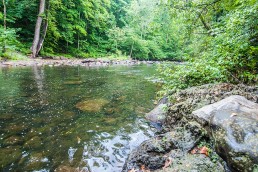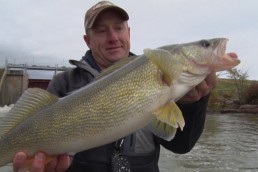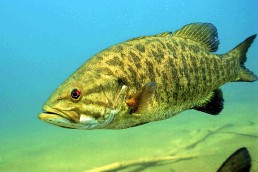Small-river Smallmouths can Rattle Your Thumb
SHARE THIS POST
They’ll shake your hand loose from the rod handle if you don’t hold on. Average stream bass are acrobats, but if you haven’t tried the little rivers you drive over trailering your boat, perhaps, you may be amazed at the size of the big ones. Lunkers are just rare enough to be a dream to attain, yet not an impossible Holy Grail that has you searching to no end. In between the lordly females and the little bass eager to slam soft plastic offerings, good-sized bronzebacks anywhere from a pound and a half to three pounds are prized.
A river is a living example of philosophy; all it asks is appreciation for what it has to offer, perhaps not bass as big as lurking in the deep waters of a favorite reservoir. Yet unmistakably, stream bass fit the environment with its boulders and eddies, fast water leading into slow stretches and 10-foot holes. I caught a smallmouth over four pounds in a stream I can cast clear across at a 45-degree angle by a flick of the wrist, and I’m convinced this wasn’t the biggest bass that river has to offer, because my son spotted another larger. He’s reliable, takes AP Calculus. Surely he can judge. Besides, he caught another bass almost as large as mine on the same afternoon.
Stories like that take some time to grow into. If you want to catch big stream smallmouths, you should get acquainted not only with one river, but a number of them in your region. It’s less about finding certain spots than about learning how to catch the feeling of where the flow leads. When you become familiar with rivers, it gets a lot easier to locate fish, not because you know where they are, but because your senses attune to the rivers’ leading you to them. You don’t just make up guesses. You get surprised when the big bass strikes, yet it all seems to make sense afterwards. Familiarity has taught you more than you can think up before you head out for the day.

So learning some basics gets you on the way. It’s probably universally agreed that soft plastics are the best lure for stream bass. Jerkbaits such as Rapalas and Rebels will catch some fish, but I never use these hard-bodied plugs from late May until September, because I’ve given them a try and have found that they’re more effective from mid-September through October when bass’s diets shift from a summer smorgasbord to soft-rayed forage fish. Likewise, in-line spinners are not very effective during the summer months when most of the stream smallmouth fishing happens. Second to soft plastics, streamer flies and nymph patterns are very productive on a fly rod.
Are you enjoying this post?
You can be among the first to get the latest info on where to go, what to use and how to use it!
Tube plastics without lead jig heads to get caught between rock crevices—just a size 1 plain shank hook—can catch bass sun-up to sunset. Mid-afternoons on hot days come alive with bass shooting out of the water towards the sun, rattling gill plates once hooked. You may be hard pressed to catch a lunker under these conditions, since these old-timers are more selective about making appearances early, late or in the rain, but average bass of a half-pound to a pound or so are fiercely pugnacious and not shy of conditions that largemouths in lakes and ponds shun.
Before tubes were invented, three-inch Mr. Twisters were my favorite, and the trick was to position a size 2 plain shank hook just right so the lure rode straight in the water. Naturally, light power spinning rods accompany such presentations, and 6-pound-test monofilament is just right. In recent years, my favorites are Senko-type worms, and rather than cast the smaller 3- or 4-inch selections, I go with full sized 5-inch worms that cast a mile, and even small bass strike them eagerly.
Especially when water is low during drought conditions, the longest cast you can possibly muster from a lure is important. Bass in slow stretches shoot from as many as 20 feet away to grab the worm, but if you get close before the presentation sails in to trick them, they’ll dash in the opposite direction just as quick.
Experience makes me prefer slow stretches to the many other stream features. Some of my favorites are no more than four feet deep at the most and productive in 2- to 3-foot rocky ranges of flat shale under which bass stalk if they’re not actively on the prowl. Don’t get stuck on sight fishing. Cast among rocks and bass dart out, take the plastic and dash back for cover. Give the fish a few seconds before you set the hook, but don’t wait so long as to gut-hook and complicate release. Deep holes may hold the largest bass, but this is not always the case. The bass my son caught earlier mentioned came from a pocket between rocks and riffles about three feet deep. This spot’s diameter wasn’t much larger than a car hood.
Does that mean this bass resided there? Evidence from many sources, including snorkeling my son and I have done, suggests that stream bass migrate between various spots on a small river or stream. We visited a hole repeatedly, which had many bass one day and none the next. This doesn’t prove anything but stands as some evidence. A honey hole or particular lair may have more value to an angler’s sentiment than catch rate. Certain places on a river do tend to be better than others, however. We have undeniable favorites, but don’t let disappointment undercut your faith in the big picture.
MWO
SHARE THIS POST
Did you enjoy this post?
You can be among the first to get the latest info on where to go, what to use and how to use it!
Bruce Edward Litton
MidWest Outdoors works with more than 200 outdoor experts each year, who contribute articles based on their areas of expertise. MidWest Outdoors magazine offers more fishing and hunting articles than any other publication!



